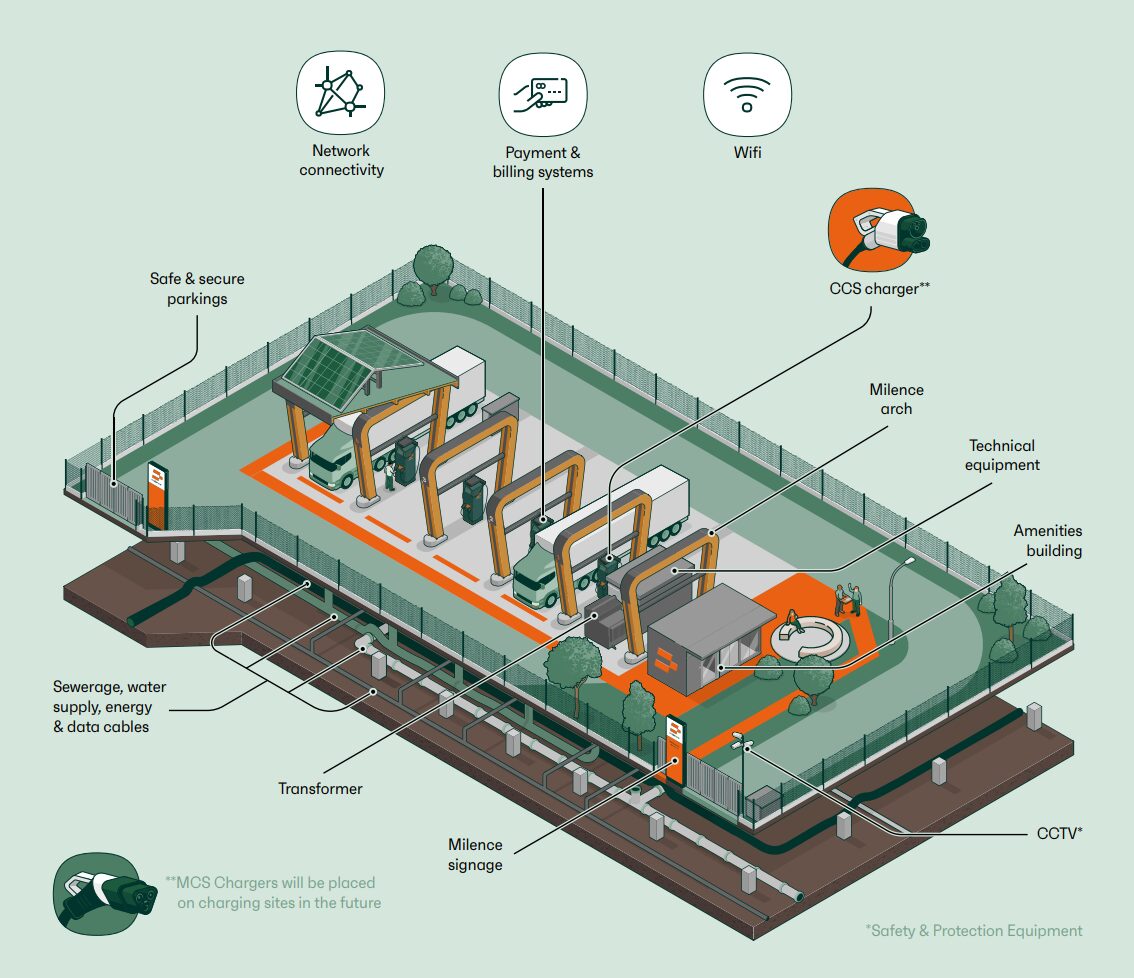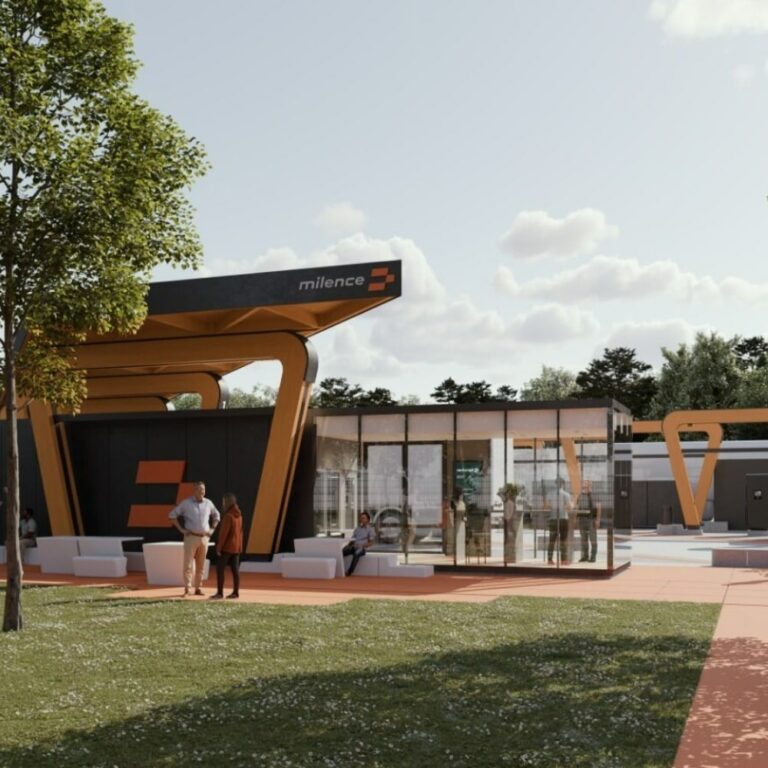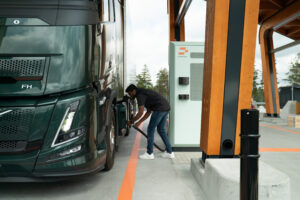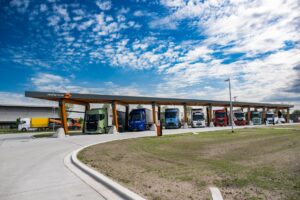The electric heavy-duty vehicle industry is growing rapidly, driven in part by technological and societal developments. This forms part of an acceleration of the global transition towards greener transport solutions via improved truck batteries, advanced charging systems, new legislations and stricter emission targets. Milence plays a key role in this transformation and is redefining what it means to be reliable, efficient, and sustainable in the transport industry.
Let’s dive into the different layers and components of the charging ecosystem, all of which are indispensable in ensuring a seamless and reliable experience for drivers of electric heavy-duty vehicles:

Charging Infrastructure & Reliability
A successful shift to fossil-free road transport relies heavily on the reliability of the underlying infrastructure. Heavy-duty vehicles often operate in demanding environments and cover long distances, making reliability crucial. While the reliability of passenger cars focused CPOs is an important factor, it is not as critical as it is for trucks. Passenger vehicles generally operate under less demanding conditions and cover shorter distances. Consequently, occasional reliability issues may be more tolerable and have less overall impact. Non-commercial consumers might be willing to compromise on reliability to some extent, influenced by other factors such as price, brand, and features. However, for trucks and heavy-duty vehicles, reliability is non-negotiable. The nature of their usage – covering long distances, often in challenging environments, while ensuring that cargo is delivered on time – makes reliability critical. Without it, the risk of disruptions increases, potentially leading to significant economic and operational consequences.
The Hardware – the Heartbeat of the Charging Hub
Imagine a world where charging an electric truck is as seamless as any routine task in our daily lives. This is the reality Milence is crafting through its charging hubs. At the core of these hubs are the chargers themselves; sophisticated structures equipped to meet every driver’s needs.
Accessible Solutions for All Vehicles: Combined Charging Systems (CCS)
At Milence’s hubs you can find CCS chargers with some of the highest power outputs available today – up to 400 kW. These systems can be installed both split and stand-alone, and are known for their adaptability, equipped with cables and connectors that can be used on both sides of the vehicle, making them suitable for the majority of eHDVs
A Leap into the Future: Megawatt Charging Standard (MCS)
Milence’s forward-thinking doesn’t end with CCS chargers. The company is pioneering the integration of MCS chargers into its network, and preparing for the next wave of eHDVs. This leap in technology underscores Milence’s commitment to not just keeping pace with the industry but setting the benchmark for what is possible.
Recognising that HDVs require significantly more power and higher reliability than passenger cars, Milence wants to make the transition to MCS chargers as soon as possible.
To make this vision a reality, Milence’s technology team collaborates closely with various partners to ensure that the best charging solutions are available for its network. A great example of this forward-thinking approach is the recent unveiling of an MCS prototype developed in collaboration with one of our partners. The MCS prototype is in its testing phase, with the goal of reaching a charging capacity of 1000A using the ISO15118-20 communication. This milestone will establish the charger as the market’s quickest charging solution, and showcases the exciting progress being made in advancing our charging capabilities.
Power Supply & Energy
In a world increasingly concerned with its carbon footprint, the source of energy for EV charging stations is of major importance. In recent years, there has been a notable surge in the momentum of renewable energy technologies, specifically solar and wind. With the increasing availability of renewable energy, the next step is bridging the gap between supply and demand. This is where smart energy hubs come into play. Smart energy hubs integrate multiple renewable energy resources, storage devices, and consumption points using advanced controls, communication, and data analytics. The goal is to improve energy efficiency, optimise energy management, reduce costs, and enhance grid reliability.
This represents a significant development. However, it also presents an immediate challenge: grid capacity. To manage the rising loads and electricity flows associated with increased demand, there is a pressing need to expand and strengthen the current transmission and distribution networks. Connecting high demand charging hubs to congested and strained grids emphasise the necessity for strategic energy management. Milence puts much effort into integrating energy storage and management systems to underscore the commitment to enhance the efficiency and reliability of our charging infrastructure.
Energy storage systems can store excess energy during periods of low demand and then redistribute this stored energy during peak times. This approach helps balance the load on the grid and secures a reliable power supply for Milence customers, fulfilling a commitment to providing uninterrupted service. energy management systems play a crucial role in optimising the operation of Milence charging facilities. The energy management systems are designed to intelligently manage the flow of electricity, ensuring that energy is used efficiently and sustainably. Through these initiatives, Milence is not just contributing to solving the immediate challenges of energy distribution but is also paving the way for a more sustainable and resilient energy future.
Beyond Charging: Control and Management Systems
Milence’s charging hubs are designed to prioritise user experience by considering various aspects of the charging process. Some key features are:
- Payment and Billing Systems: Users can conveniently pay for charging services using card readers, mobile apps, or subscription services. These systems not only enhance user convenience but also assist operators in managing transactions efficiently.
- Network Connectivity: Milence charging hubs are equipped with wired internet connectivity that establishes and maintains a robust and secure connection with a central system. This connectivity allows for remote monitoring, effective management, and timely firmware updates, ensuring the stations operate optimally.
- Network Operating Center: A critical component and the central hub of on-site operations, monitoring site activity and maintenance. This centre is essential for addressing technical issues, offering emergency services, ensuring drivers have a seamless charging experience by being the basis for optimal operations.
Advanced Software Integration
Milence leverages cloud-based services to power, monitor, and optimise its charging ecosystem. This software integration allows for real-time management of charging operations, from individual charger status to overall hub performance. The integration of advanced data analytics not only streamlines the charging process, and minimises energy waste, but also bolsters the reliability of the charging network. This dual impact enhances the overall user experience, crucial in making a successful transition to fossil-free road transport.
Safety and Protection Equipment
The significance of safety and protection equipment at charging hubs is underscored by the complexity of these installations, encompassing over a thousand pieces of electrical equipment. Safety measures, including advanced protection systems against overcurrent and other electrical threats, play a crucial role in ensuring the well-being of the user, charging infrastructure, and connected heavy-duty vehicles. Additionally, the design of the charging hub itself is of importance. A well-thought-out design – including proper placement of the equipment, clear signage and effective traffic flows – not only enhances the overall efficiency, but also contributes significantly to on-site safety.
Conclusion
Each element of the charging hub plays a vital role in delivering a safe, efficient, and user-friendly charging experience. The integration of these components enables EV truck drivers to charge their vehicles conveniently and safely, supporting the broader adoption of electric mobility.
By focusing on reliability and sustainability, Milence is not just supporting the growth of electric trucking; it’s leading it. As this ecosystem is visualised, it’s clear that the connection between technology, energy management, and environmental practices is key. This holistic approach ensures that the future of freight is not only electric but sustainable and efficient.



